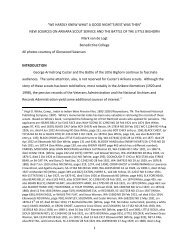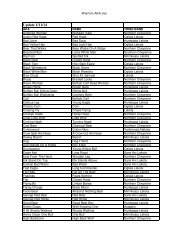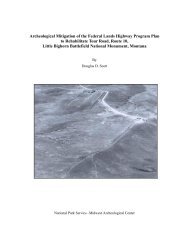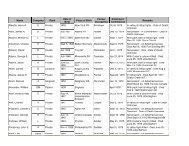Investigating the Oxbows and Testing Metal Detector Efficiency
Investigating the Oxbows and Testing Metal Detector Efficiency
Investigating the Oxbows and Testing Metal Detector Efficiency
You also want an ePaper? Increase the reach of your titles
YUMPU automatically turns print PDFs into web optimized ePapers that Google loves.
fur<strong>the</strong>r southwest in 1876 or 1877 than it is today. Old me<strong>and</strong>er scars are clear on <strong>the</strong> 2005<br />
orthophotograph of <strong>the</strong> valley between Deep Ravine <strong>and</strong> Medicine Tail Coulee suggesting <strong>the</strong><br />
river flowed fur<strong>the</strong>r southwest at one time in <strong>the</strong> past. The problem with this interpretation is that<br />
<strong>the</strong> bluffs <strong>and</strong> river banks in this same area are also shown as reaching far<strong>the</strong>r southwest on this<br />
Maguire map. Erosion of nearly a quarter mile from a high bluff to open flat valley seems<br />
unlikely in less than 100 years. The river configuration at <strong>the</strong> Custer field was documented in an<br />
aerial photograph taken in 1935 which is <strong>the</strong> earliest aerial photography of <strong>the</strong> river that is<br />
known. Although <strong>the</strong>re are some differences in <strong>the</strong> river channel <strong>and</strong> particularly <strong>the</strong> size <strong>and</strong><br />
configuration of <strong>the</strong> lower oxbows between <strong>the</strong> 1935 aerial imagery <strong>and</strong> <strong>the</strong> 2005 imagery, <strong>the</strong>re<br />
are no significant channel changes. It seems appropriate to suggest that <strong>the</strong> river channel<br />
depicted on <strong>the</strong> Maguire 8 map between Deep Ravine <strong>and</strong> Medicine Tail Coulee is in part in<br />
error. This subjective assessment is in concert with <strong>the</strong> high RMS error rate for <strong>the</strong> map.<br />
P. H. Norris Map Compared to 2005 Orthophotographic Map<br />
Philetus Norris visited <strong>the</strong> battlefield <strong>and</strong> recovered <strong>the</strong> skeletal remains of Charley Reynolds in<br />
July 1877. Norris is supposed to have created a map of <strong>the</strong> battlefield at that time, but it was lost<br />
in <strong>the</strong> mail <strong>and</strong> never arrived at <strong>the</strong> New York Herald newspaper. Norris apparently redrew <strong>the</strong><br />
map <strong>and</strong> it was printed in 1884 (Donahue 2008b:50-53). The Norris published map appears to be<br />
a simplification of a Maguire map with additions by Norris from his own observations <strong>and</strong> those<br />
of Fred Gerard. The Norris map is one of <strong>the</strong> better early maps (Figure 9) in terms of a low RMS<br />
error value compared to <strong>the</strong> 2004 imagery of <strong>the</strong> battlefield. The l<strong>and</strong> features, some river<br />
me<strong>and</strong>ers, <strong>and</strong> battlefield features seem to align quite well. Squaw Creek is not quite accurate,<br />
but he does note a slough in <strong>the</strong> valley that corresponds to <strong>the</strong> Pretty White Buffalo Woman Map<br />
<strong>and</strong> such a feature still exists today (Scott <strong>and</strong> Donahue 2010:10). The Norris map has a 100meter<br />
RMS error or about 330 feet. It is consistent with <strong>the</strong> Maguire maps from which it was<br />
likely copied in part. The Norris map depicts <strong>the</strong> river channel that runs along <strong>the</strong> Custer field<br />
area in nearly <strong>the</strong> same configuration as <strong>the</strong> Maguire 8 map, <strong>and</strong> <strong>the</strong> comments on its’ accuracy<br />
in this area are <strong>the</strong> same as for <strong>the</strong> Maguire 8 map.<br />
John Blake (1883) <strong>and</strong> Eugene Sampson (1901) Maps Compared to 1967 Topographic Map<br />
John Blake was a contract General L<strong>and</strong> Officer surveyor who was hired to map <strong>the</strong> internal<br />
cadastral divisions of Township 3 South <strong>and</strong> Range 35 East, as well as record <strong>the</strong> arable l<strong>and</strong> in<br />
<strong>the</strong> Little Bighorn River valley. His1883 map notes Fort Custer used some of <strong>the</strong> valley l<strong>and</strong> as<br />
hayfields for it livestock forage (Donahue 2008b:254-256) <strong>and</strong> it charts <strong>the</strong> river location with its<br />
attendant me<strong>and</strong>ers (Figure 10). In 1901 Eugene Sampson resurveyed <strong>the</strong> township (Figure 11).<br />
Sampson notes on <strong>the</strong> map state he took <strong>the</strong> river me<strong>and</strong>ers from ano<strong>the</strong>r source, likely Blake’s<br />
1883 map, making <strong>the</strong> accuracy of <strong>the</strong> river depiction in 1901 questionable to some degree. The<br />
Blake <strong>and</strong> Sampson maps <strong>and</strong> <strong>the</strong> 2005 imagery match very well (Figure 10, 11), reflecting <strong>the</strong><br />
quality of <strong>the</strong> work <strong>the</strong> surveyors did with <strong>the</strong>ir chain <strong>and</strong> optical transits that were <strong>the</strong> tools of<br />
<strong>the</strong> day for <strong>the</strong> western l<strong>and</strong> surveyor. The RMS error for <strong>the</strong> maps is 8.4 <strong>and</strong> 14.6 meters (27.5<br />
<strong>and</strong> 47.9 feet respectively) or well within tolerance of a line width or a point on a map, about a<br />
19








